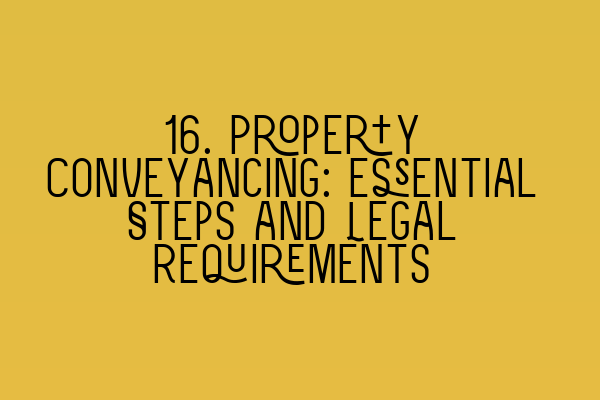16. Property Conveyancing: Essential Steps and Legal Requirements
When it comes to buying or selling a property, the process can be complex and overwhelming. Property conveyancing is the legal process of transferring the ownership of a property from one person to another. It involves several essential steps and legal requirements that must be followed in order to ensure a smooth transaction. In this article, we will discuss the key steps involved in property conveyancing and the legal obligations that both buyers and sellers must adhere to.
Step 1: Instruction of a Solicitor
The first step in the property conveyancing process is to instruct a solicitor who specializes in property law and land law. A solicitor will act on your behalf and handle all the legal aspects of the transaction. It is crucial to choose a solicitor with relevant experience and expertise to ensure that your interests are protected throughout the process. If you are studying to become a solicitor, make sure to check out our SQE 1 Practice Exam Questions for comprehensive preparation.
Related Article: SQE 1 Practice Exam Questions
Step 2: Drafting and Reviewing Contracts
Once you have instructed a solicitor, they will begin the process of drafting and reviewing the contracts for the sale or purchase of the property. These contracts outline the terms and conditions of the transaction, including the purchase price, completion date, and any special conditions agreed upon by both parties. It is essential that these contracts are carefully drafted and reviewed to ensure that they accurately reflect the intentions of the parties involved.
Step 3: Searches and Investigations
Before completing the property transaction, several searches and investigations must be conducted to ensure that there are no hidden issues or concerns. These searches may include local authority searches, environmental searches, and drainage and water searches. The purpose of these searches is to uncover any potential problems, such as planning restrictions, contaminated land, or flooding risks. Your solicitor will review the search results and advise you on any issues that may need further investigation or consideration.
Step 4: Exchange of Contracts
Once all the necessary searches and investigations have been completed, both parties are ready to exchange contracts. The exchange of contracts is a significant milestone in the property conveyancing process as it legally binds both the buyer and the seller to the transaction. At this stage, the buyer is typically required to pay a deposit, usually 10% of the purchase price, which is held by the seller’s solicitor or a stakeholder until completion.
Step 5: Completion
The completion date is the agreed-upon date when the ownership of the property is transferred from the seller to the buyer. On the completion day, the buyer’s solicitor will transfer the remaining funds to the seller’s solicitor, and the keys to the property will be handed over. The completion process typically involves the payment of outstanding fees and taxes, registration of the property with the Land Registry, and the transfer of any existing mortgages.
Step 6: Post-Completion Matters
After the completion of the property conveyancing process, there are still some post-completion matters that need to be addressed. These include notifying utility companies of the change in ownership, updating the Land Registry records, and transferring any existing insurance policies. Your solicitor will guide you through these additional steps to ensure a smooth transition into your new property.
Related Article: SQE 1 Preparation Courses
Legal Requirements
In addition to the steps outlined above, there are certain legal requirements that must be met during the property conveyancing process. These legal obligations aim to protect the rights and interests of both buyers and sellers. Some of the key legal requirements include:
- Obtaining the seller’s title deeds and ensuring that they have the legal right to sell the property.
- Conducting relevant searches and investigations to identify any potential issues or concerns.
- Ensuring that all necessary contracts and agreements are properly drafted, reviewed, and executed.
- Completing the necessary paperwork, including the transfer of ownership forms and mortgage documentation.
- Registering the property with the Land Registry to officially transfer the ownership.
By adhering to these legal requirements, both buyers and sellers can ensure a legally sound and secure property transaction.
Related Article: SRA SQE Exam Dates
Conclusion
Property conveyancing involves various essential steps and legal requirements that must be followed to ensure a successful and legally binding transaction. By instructing a solicitor, drafting and reviewing contracts, conducting searches and investigations, exchanging contracts, completing the transaction, and addressing post-completion matters, both buyers and sellers can navigate the conveyancing process with confidence. It is crucial to seek professional advice and guidance throughout the process to ensure that your rights and interests are protected. If you are preparing for your solicitor qualification exams, make sure to check out our SQE 2 Preparation Courses for comprehensive study materials.
Related Articles:
